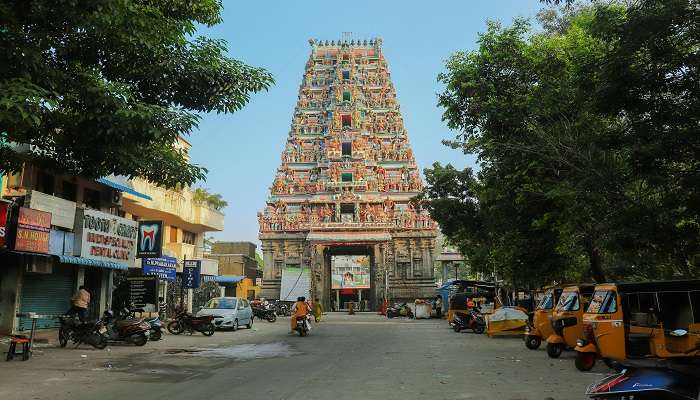Hoysaleswara Temple: Unraveling the Splendor of Ancient Architecture
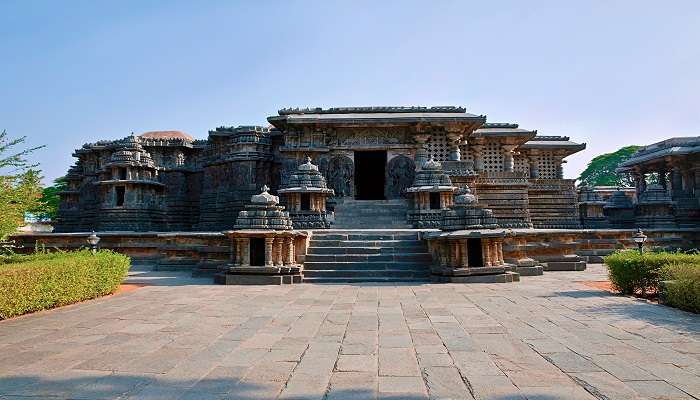
Located in the historic town of Halebid in Karnataka, the Hoysaleswara temple is an architectural marvel that symbolises the creativity and skills of the Hoysala dynasty. This grand temple structure is a true masterpiece of Indian rock-cut architecture, noted for its detailed stone carvings and stunning sculptural details.
As you approach the temple, you will be immediately amazed by its grandeur and the sheer artistry that has gone into its construction. Whether you’re interested in history or architecture or appreciate beauty, visiting the Hoysaleswara temple is a must. It will leave you in awe and deepen your appreciation for India’s rich cultural heritage. This article will explore the Hoysaleswara temple, covering everything you need to know.
Hoysaleswara Temple: An Overview
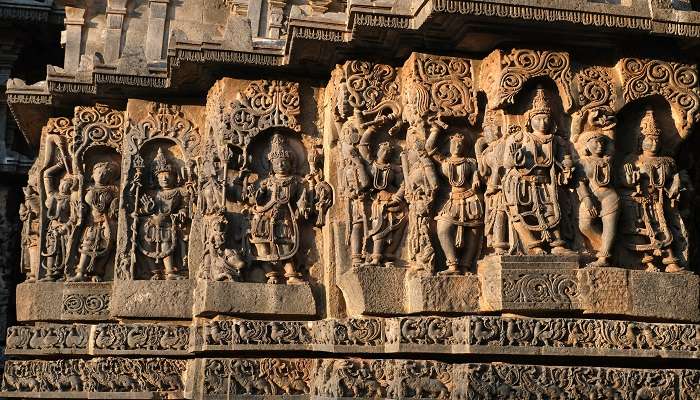
The Hoysaleswara temple, or the Halebidu temple, embodies Karnataka’s history and craftsmanship. Built-in the 12th century, it is a Hindu temple dedicated to Shiva and the grandest structure in Halebidu, which was once the capital of the Hoysala Empire.
This architectural marvel is known for its detailed stone carvings and detailed work, which showcase the brilliance of Hoysala architecture. The vast temple complex has elaborately sculpted outer walls, a serene main sanctuary, and a surrounding garden that adds to the peaceful ambience. Visiting Hoysaleswara temple is a journey back in time, offering a glimpse into India’s rich cultural heritage.
Must Read: Temples in Tamil Nadu
Hoysaleswara Temple History
This temple of Lord Shiva is steeped in the rich history of the Hoysala Empire. It has a rich history, which is as follows:
1. Royal Commission and Construction
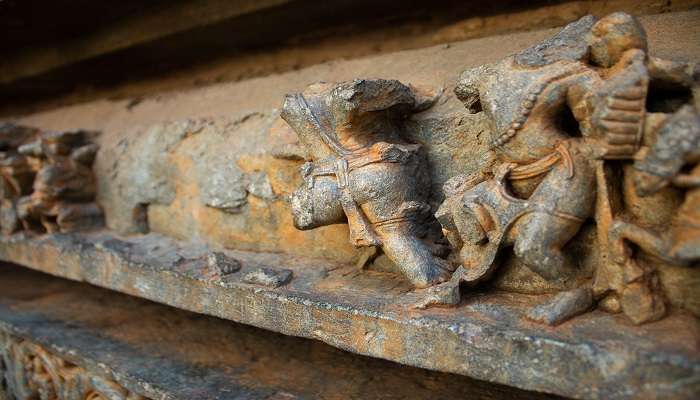
- The temple’s construction began in the 12th century, commissioned by King Vishnuvardhana, a prominent ruler of the Hoysala dynasty.
- Halebidu, then known as Dorasamudra, was the flourishing capital of the Hoysala Empire during this period. The temple’s grandness reflects the empire’s power and wealth.
2. Architectural Marvel

- The temple uses soapstone, a soft stone ideal for detailed carvings, and displays Hoysala architecture.
- The outer walls are decorated with sculptures portraying deities, mythological figures, and scenes from epics like Ramayana and Mahabharata. This elaborated artwork showcases the exceptional craftsmanship of Hoysala artisans
- The temple complex has two shrines, one for King Vishnuvardhana and another for his queen, showcasing the royal connection.
3. Shifting Fortunes
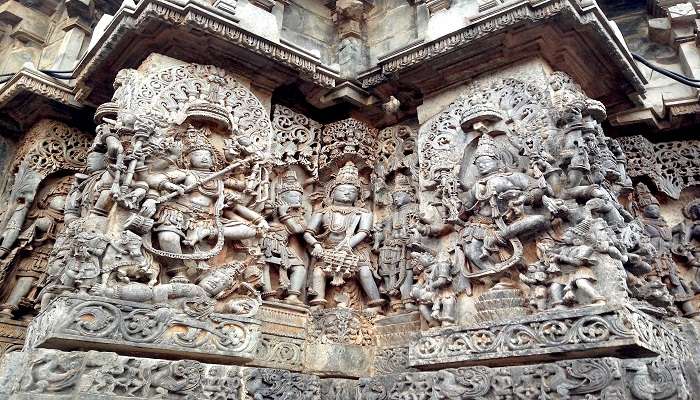
- The temple’s construction spanned several decades and continued under later Hoysala kings.
- Unfortunately, in the 14th century, Halebidu was invaded, leading to the decline of the Hoysala Empire. The temple was looted and damaged.
- Despite the setbacks, the Hoysaleswara temple remains a remarkable testament to Hoysala’s artistry and cultural legacy.
4. Enduring Legacy
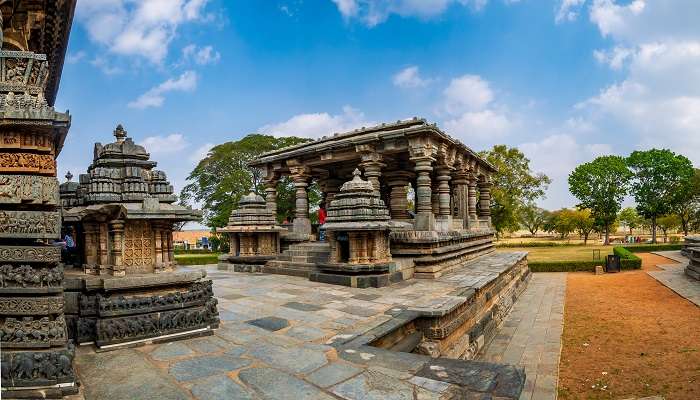
- Today, the Hoysaleswara temple is a protected monument under the Archaeological Survey of India (ASI).
- Halebidu, along with the nearby town of Belur, which also houses Hoysala temples, is a popular tourist destination that attracts visitors interested in history, art, and architecture.
Significance of Hoysaleswara Temple
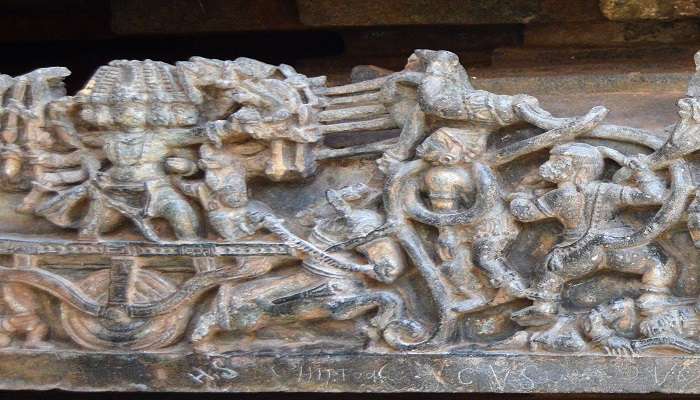
The Hoysaleswara temple is a marvel of Indian architecture and history. It is a testament to the exquisite craftsmanship of the Hoysala era and stands as a UNESCO World Heritage Site. Let’s have a look at its significance:
Architectural Brilliance- The temple exemplifies Hoysala architecture, which is known for its intricate soapstone carvings. The outer walls are adorned with sculptures depicting mythology, nature, and daily life scenes.
Dedication to Shiva – As the name suggests, the Hoysaleswara Temple is dedicated to Lord Shiva. The temple complex also includes twin shrines—one for the king and one for the queen, each with a Shiva Linga. The exquisite sculptures and artwork depict various aspects of Hinduism.
Historical Legacy – Halebidu once served as the capital of the Hoysala Empire. The Hoysaleswara temple stands as a symbol of the empire’s power and prosperity. Though ravaged by invasions in the 14th century, the temple’s grandeur endures.
Sculptural Marvel – The sheer number of sculptures adorning the temple walls is staggering. From intricate depictions of gods and goddesses to scenes from epics like Ramayana and Mahabharata, the temple is a visual treat for history and art enthusiasts.
UNESCO World Heritage Site – In 1986, the Hoysaleswara temple and other Hoysala monuments at Halebidu were honoured as UNESCO World Heritage Sites because of their incredible historical and cultural values.
Suggested Read: 13 Hindu Temples in Rajasthan
Hoysaleswara Temple: Design, Structure, and Architecture
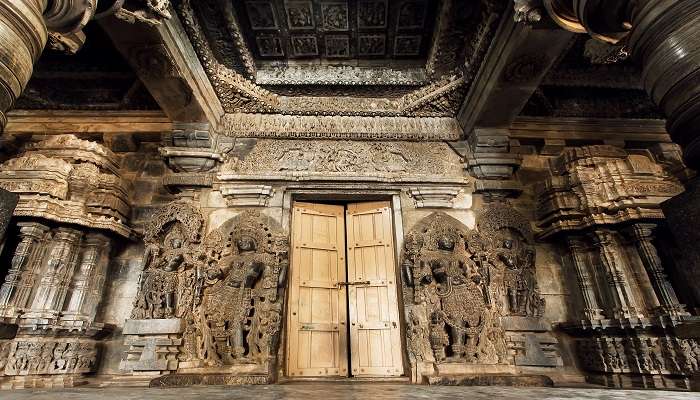
The Hoysaleswara temple is a remarkable twin Hindu temple. It consists of two equally sized shrines dedicated to Shiva – one called Hoysaleswara (for the king) and the other Shantaleswara (for the queen Shantala Devi). The sanctums of both shrines face east towards the rising sun and enshrine Shiva lingas.
The temple complex sits on an elevated platform meant for circumambulation. In the front are two large open mandapas connected to the shrines. Initially, there would have been towering shikhara atop the sanctums, but they are now lost. The temples are built of green chloritic schist stone, easily carved but hardened over time.
The outer walls are profusely decorated with intricate friezes and carvings arranged in horizontal bands. These include friezes depicting elephants, lions, and horses, scenes from Hindu epics and Puranas, divine imagery, courtly life, and erotic sculptures. Over 340 large carved reliefs narrate stories from texts like the Ramayana, Mahabharata, and Bhagavata Purana.
The entrances have exquisitely carved dvarapalas (door guardians) in various poses. Inside, the pillars of the mandapas are masterfully lathe-turned and contain madanakai (salabhanjika) sculptures, some of which are still intact. The sanctum interiors are relatively plain to focus attention on the linga.
The temple premises also have shrines for Nandi and Surya, and likely once for Chandra. The temple compound also contains an archaeological museum housing recovered sculptures and artefacts. Overall, the Hoysaleswara temple is renowned for its incredible architectural and sculptural artistry from the Hoysala era.
Hoysaleswara Temple: Best Time to Visit
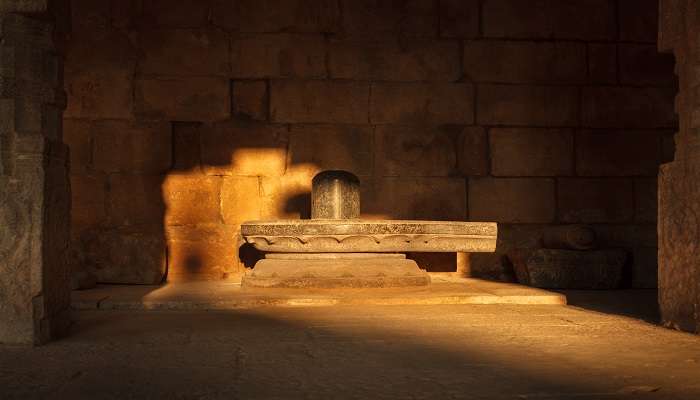
The best time to visit the Hoysaleswara temple in Halebidu is from October to March. You can also visit this temple around March when the Hoysala Mahotsava takes place. It is a vibrant dance festival that showcases Karnataka’s cultural heritage.
Suggested Read: 12 Majestic Temples in Rishikesh
How to Reach Hoysaleswara Temple?
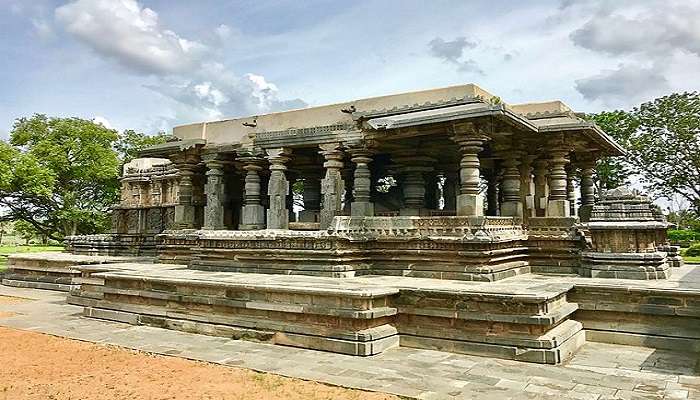
You can reach the Hoysaleswara temple in these ways:
By Road
- Halebidu is approximately 30 Km away from Hassan city.
- If you’re travelling from Bengaluru, the distance to Halebidu is about 210 Km.
- The temple is accessible via the AH43 highway and the Hindu Hrudaysamrat Balasaheb Thackeray Maharashtra Samruddhi Mahamarg.
By Air
- The nearest major airports to Halebidu are Mangalore Airport (approximately 168 Km) and Kempegowda International Airport in Bengaluru (approximately 230 km). Both airports serve international and domestic flights.
- You can reach Halebidu by road by hiring a taxi or using buses from either of these airports.
By Rail
- These two railway stations are accessible from Halebidu – Hassan Railway Station (approximately 33.6 Km) and Belur Railway Station (approximately 14.7 Km).
- You can hire a cab from Hassan or Belur railway station, take a bus, or use an autorickshaw to reach the temple.
Hoysaleswara Temple Timings
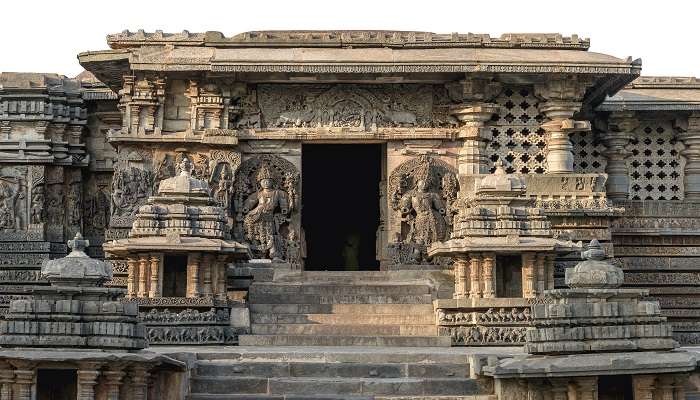
The Hoysaleswara temple timings for opening and doing pooja are:
| Daily temple Opening | 06:30 AM |
| Daily temple Darshan | 06:30 AM to 09:00 PM |
| Daily temple Closing | 09:00 PM |
| Morning Abhisheka | 06:30 AM to 09:00 AM |
| Morning Darshana | 09:00 AM to 12:30 PM |
| Afternoon Abhisheka | 12:30 PM to 01:30 PM |
| Evening Darshana | 01:30 PM to 05:00 PM |
| Evening Abhisheka | 05:00 PM to 06:00 PM |
Suggested Read: Kataragama in Sri Lanka
Hoysaleswara Temple: Dress Code
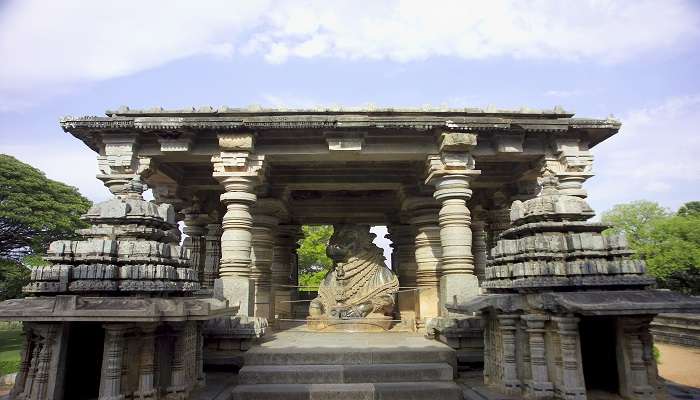
There isn’t a strict dress code enforced at the Hoysaleswara temple. However, as a place of worship, modest dress is recommended.
- For men, wearing a dhoti, kurta, or full-length pants with a shirt or kurta is ideal.
- Women should wear a saree, salwar kameez, or long skirt with a kurta or top.
- Sleeveless tops, low-cut clothing, shorts, and skirts above the knee are best avoided.
- Opt for comfortable, breathable clothing, especially during the hot summer months.
- Shoes and socks need to be removed before entering the temple complex.
Hoysaleswara Temple: Things to Keep in Mind
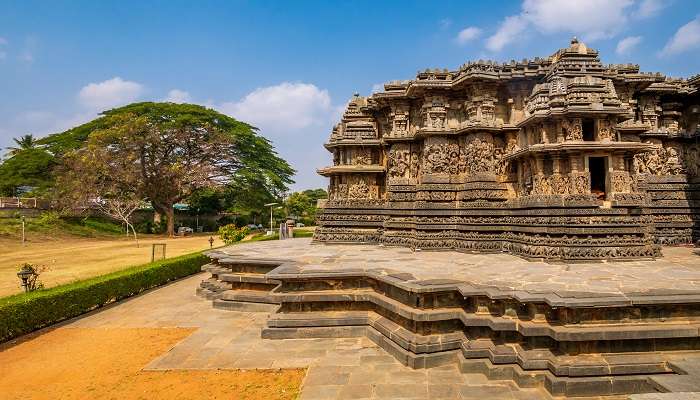
Some things to keep in mind when visiting the Hoysaleswara temple are:
- The temple is open from 7 am to 9 pm.
- The detailed designs and sculptures on the temple walls depict scenes from Hindu mythology and historical events. A guide can help you appreciate the finer details and the stories behind them. The charges are around ₹300 per person.
- The Hoysaleswara temple is a place of worship, so it is recommended that you dress modestly. This means covering your shoulders and knees
- It is customary to remove your shoes before entering the temple complex.
- You can take photos of the temple, but using a flash is prohibited.
- The temple is a place of worship, so please respect those praying or meditating.
Further Read: 6 Must-Visit Buddhist Temples in Sri Lanka
Visiting the Hoysaleswara temple in Halebidu is a mesmerising journey through ancient art, architecture, and spirituality. Its detailed carvings, towering pillars, and rich history offer a glimpse into India’s glorious past.
To experience this architectural marvel firsthand, book your trip to Karnataka today and explore the Hoysaleswara temple. Explore tour packages that take you through this incredible temple and other architectural wonders of this region. Don’t miss the chance to experience the living legacy of India’s glorious past – plan your visit now!
For our editorial codes of conduct and copyright disclaimer, please click here.
Cover Image Source: Shutterstock
Frequently Asked Questions About Hoysaleswara Temple
What is the Speciality of Hoysaleswara Temple?
The Hoysaleswara Temple, also known as the Halebidu Temple, is a 12th-century Hindu masterpiece dedicated to Lord Shiva. It graces the town of Halebidu in Karnataka, India, once the capital of the Hoysala Empire. Constructed between 1121 CE and 1160 CE, this temple houses elaborate sculptures and stunning reliefs.
Who destroyed the Hoysaleswara Temple?
Tragically, during the early 14th century, the temple faced devastation due to Muslim invasions from the Delhi Sultanate. Consequently, it fell into disrepair and neglect.
Why is the Hoysala temple famous?
The Hoysaleswara Temple’s fame lies in its exquisite carvings and iconographic richness. Around 340 large reliefs adorn its walls, depicting Hindu mythology, epics like the Ramayana and Mahabharata, and the Bhagavata Purana.
Which temple was famous during the Hoysala dynasty?
The Hoysaleswara Temple is famous for the Hoysala dynasty. It is a twin temple dedicated to both Hoysaleswara and Santaleswara Shiva lingams. These lingams represent the masculine and feminine aspects, equal and joined at their transept.
What are the two famous temples of Hoysala?
Apart from the Hoysaleswara Temple, two other famous temples associated with the Hoysala dynasty are:
- Belur Chennakeshava Temple: Located in Belur, Karnataka, it dazzles with its sculptural finesse.
- Shravanabelagola Jain Temple: A pilgrimage site for Jains, it boasts the monolithic statue of Lord Gomateshwara.
People Also Read:
Meenakshi Temple Wat Phra That Doi Suthep Wat Rong Khun

Experience the world through captivating stories of adventure and travel. As a senior content writer, I bring my passion for exploration to life, crafting tales that take you on a journey. With my words, you’ll feel the thrill of discovery and the joy of experiencing new cultures. Let me turn your imagination into a reality with stories that inspire you to explore and embrace the world.




